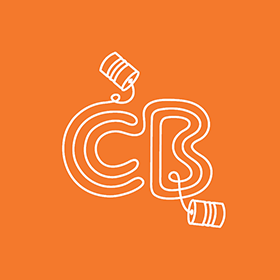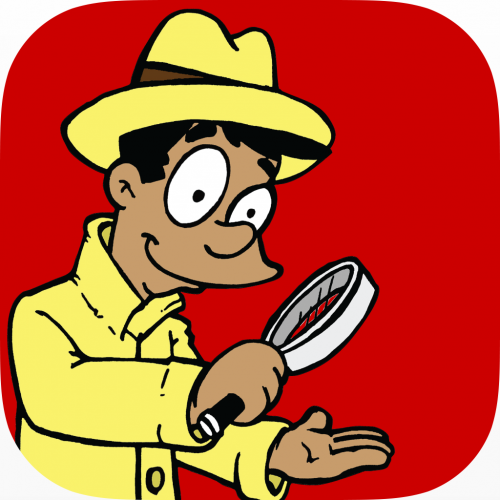 Every one of us is a Social Detective! We are good social detectives when we use our eyes, ears, and brains to figure out what others are planning to do next or are presently doing and what they mean by their words and actions.
Every one of us is a Social Detective! We are good social detectives when we use our eyes, ears, and brains to figure out what others are planning to do next or are presently doing and what they mean by their words and actions.
This entertaining and engaging app offers repeated practice to develop social detective skills. This interactive app teaches children ages 7-12 to become better social thinkers by putting on their detective hats and deciphering both expected and unexpected social behavior. Users will rely on their eyes, ears and brains to make smart social guesses and investigate clues to see how others’ emotions and responses are connected to their own behavior.
You are a Social Detective! App is the first level of the Social Detective CD. (This is a blessing to all of you, who are like me and haven’t owned a laptop with a CD drive for over 2 years!). I was told this app was in development back in January, when I attended a Social Thinking Conference in Long Beach. I’ve since been waiting for it to be released. It certainly did not disappoint.
The app’s creators put together a short video to explain the app, you can watch it HERE.
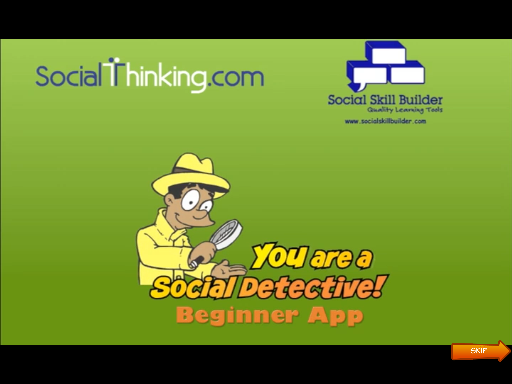
The app itself is easy to use. Moving through the different steps is also intuitive. The first step involves choosing an avatar. The child can choose from the different options available by assigning his/her name.
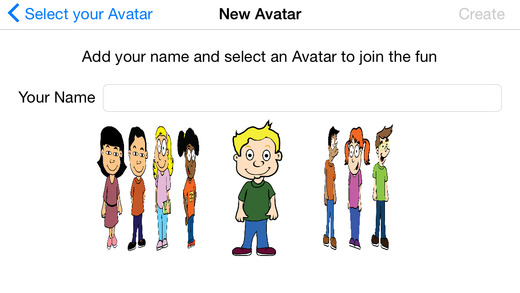
The app also allows the students to review their “Social Smarts.” I like to use the Social Detective Comic Book as a review before using the app. However, the quick review is handy before the students start practicing their skills on the app. (You have the option to “skip” the review if you are using the app with the same student over multiple sessions).
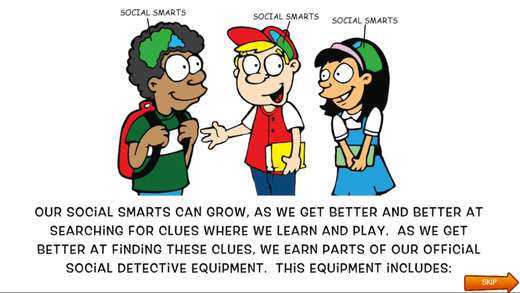
For each of the three levels in the app, there is a pretest. Students must get 100% on the pretest before they can move on to the ‘test’ portion for each level.
Essentially, the goal of the app is for each player/student to become a social detective by earning:
1) A Detective Coat: To earn the detective coat, the student must be able to tell which behaviors are expected and which ones are unexpected. The app includes 3 still images (pretest) and 16 short videos. For each video the student must identify if the behavior was “expected” or “unexpected.”
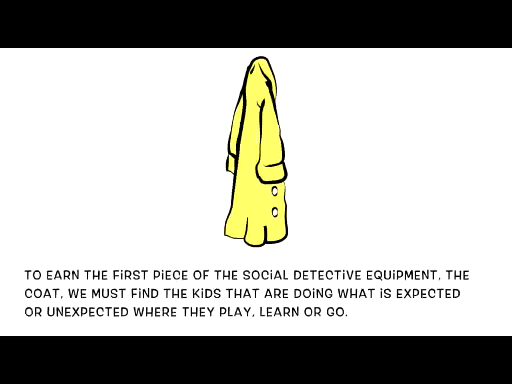
2) A Detective Hat: To earn the hat, they must show they know and understand the difference between good thoughts and uncomfortable thoughts. Students must identify verbal and nonverbal clues from the videos to show if someone was having good thoughts or uncomfortable thoughts. The app includes 3 still images (pretest), and 12 short videos. For each video the student must identify if the individual is having “good,” or “uncomfortable” thoughts.
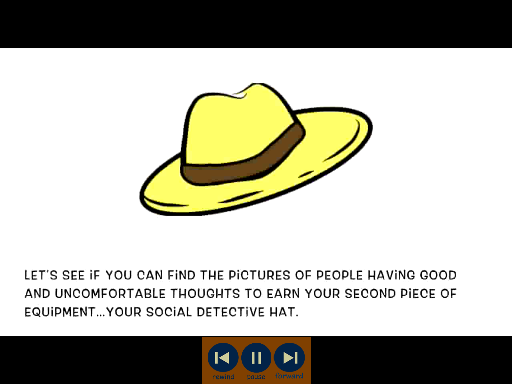
3) A Magnifying Glass: The students earn their magnifying glass to complete their Social Detective ensemble by using all of their skills to make smart guesses. The students are required to use their social skill “tools” (eyes, ears, brains) to predict what they think will probably happen next. The app includes 3 still images (pretest) and 24 short videos. This section is challenging because there are two answers per question and does require thought and reasoning.
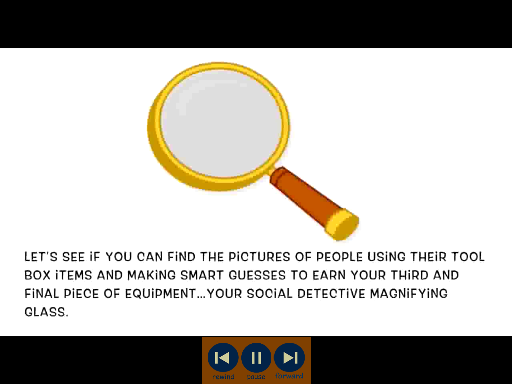
Elementary school-aged (K-5) students, and immature older middle and high school students who enjoy playing on the iPad, may benefit from this app. However, this isn’t just an app for students who have challenges relating to autism spectrum disorders. The lessons also offer a variety of engaging ways to introduce the concepts of social thinking to general education students who may have difficulties with social nuances, emotional disabilities, and younger students with challenges in higher order reasoning. This app also keeps data for the past 5 sessions per student per level.
Overall, I thought the videos used in the app were appropriate for a wide range of ages. Videos included scenes from a school, playground, lunchroom, and home. This further widens the scope of its application. I definitely think it is a handy “tool” for Social Thinking therapists and teachers. You can buy it at the app store for $24.99.
Disclaimer: The app was provided for review. However, all the opinions and content of the blog are the author’s.
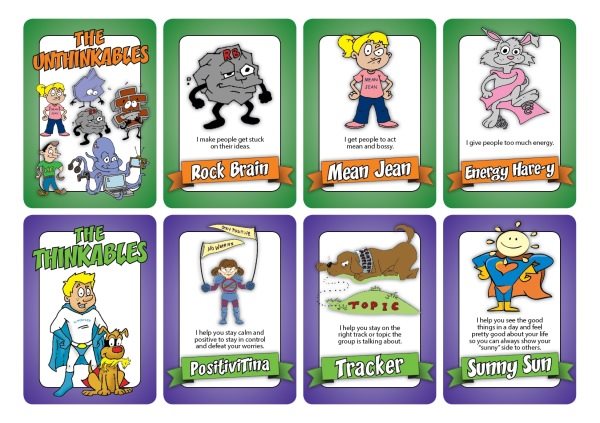
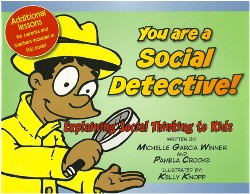 Getting started with the Social Thinking Curriculum by Michelle Garcia Winner is always a challenge. Most of us, Speech-Language Pathologists, fall under two distinct categories: 1) “Read first Therapists” that like to read and study a program until it we can recite it in our sleep before we will begin to implement it on our students, 2) “Try it out first Therapists” that will try to figure out the program while we implement it on our students.
Getting started with the Social Thinking Curriculum by Michelle Garcia Winner is always a challenge. Most of us, Speech-Language Pathologists, fall under two distinct categories: 1) “Read first Therapists” that like to read and study a program until it we can recite it in our sleep before we will begin to implement it on our students, 2) “Try it out first Therapists” that will try to figure out the program while we implement it on our students.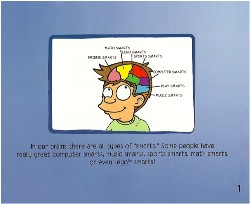
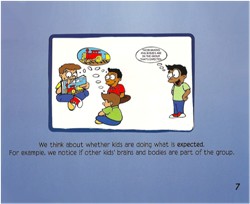 Versus
Versus 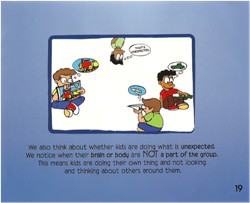
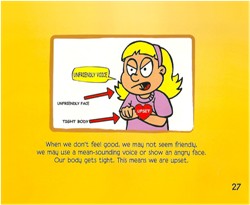 The book also explains “being upset” in explicit physical terms (mean sounding voice, angry face, body gets tight) so children can identify their own states when they get upset.
The book also explains “being upset” in explicit physical terms (mean sounding voice, angry face, body gets tight) so children can identify their own states when they get upset.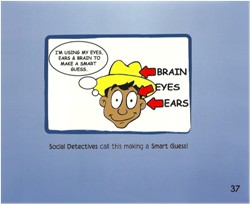 Another challenge a lot of my little ones have is identifying and differentiating between peers who are nice and friendly and others who say or do mean things. The book has tables (page 44 and 45) to help the child identify and list characteristics of a “nice person” and a person who is “not nice to talk to.” In addition, the book also has a glossary with definitions of the Social Thinking vocabulary for quick reference. The book also includes three lesson plans at the end of the book for “Expected Vs Unexpected Behaviors,” “Social Spy,” and “Social Detective.”
Another challenge a lot of my little ones have is identifying and differentiating between peers who are nice and friendly and others who say or do mean things. The book has tables (page 44 and 45) to help the child identify and list characteristics of a “nice person” and a person who is “not nice to talk to.” In addition, the book also has a glossary with definitions of the Social Thinking vocabulary for quick reference. The book also includes three lesson plans at the end of the book for “Expected Vs Unexpected Behaviors,” “Social Spy,” and “Social Detective.”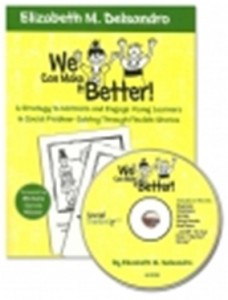 A majority of my caseload includes preschool and early elementary aged students. Many of them are diagnosed with Autism or demonstrate social skill deficits. If you’re like me and work with the younger students, you know how hard it is to find social skill programs that are structured, but still age appropriate. For the last year or so, the Social Thinking Curriculum has been the go-to program for many therapists to build social skills. However, finding materials that are appropriate for this age group has always been a challenge. In many settings including the public schools the Social Thinking curriculum isn’t incorporated until upper elementary or middle school years. Does that mean that the Social Thinking Curriculum isn’t appropriate for the preschool age group? In my opinion the preschool and early elementary age group is ideal to begin teaching the Social Thinking Curriculum. Introducing the Social Thinking vocabulary and concepts early on makes them a part of their everyday lives and routine. It does present unique challenges though: 1) teaching the vocabulary in ways that makes sense to younger students and 2) preparing lessons that are age appropriate, engaging and flexible.
A majority of my caseload includes preschool and early elementary aged students. Many of them are diagnosed with Autism or demonstrate social skill deficits. If you’re like me and work with the younger students, you know how hard it is to find social skill programs that are structured, but still age appropriate. For the last year or so, the Social Thinking Curriculum has been the go-to program for many therapists to build social skills. However, finding materials that are appropriate for this age group has always been a challenge. In many settings including the public schools the Social Thinking curriculum isn’t incorporated until upper elementary or middle school years. Does that mean that the Social Thinking Curriculum isn’t appropriate for the preschool age group? In my opinion the preschool and early elementary age group is ideal to begin teaching the Social Thinking Curriculum. Introducing the Social Thinking vocabulary and concepts early on makes them a part of their everyday lives and routine. It does present unique challenges though: 1) teaching the vocabulary in ways that makes sense to younger students and 2) preparing lessons that are age appropriate, engaging and flexible.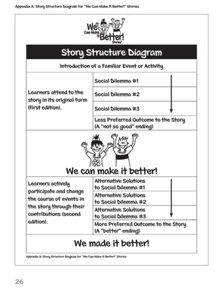 Appendix A describes the story structure. The first edition contains the social dilemmas, while the second provides solutions so the ending is a preferred ending.
Appendix A describes the story structure. The first edition contains the social dilemmas, while the second provides solutions so the ending is a preferred ending.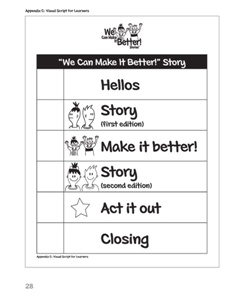 Appendix C provides a visual script for the lesson.
Appendix C provides a visual script for the lesson.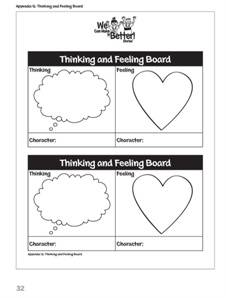 Appendix G provides a visual link between people’s thoughts and their feelings. This could be a very powerful and versatile tool. It could be used for far more activities than just the lessons in this program.
Appendix G provides a visual link between people’s thoughts and their feelings. This could be a very powerful and versatile tool. It could be used for far more activities than just the lessons in this program.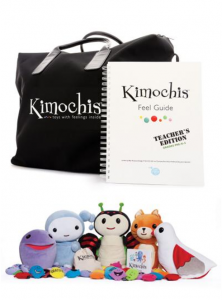 After 11 years in the field, I finally came across a curriculum that made teaching emotions a fun and positive learning experience. I was fortunate enough to be able to attend a presentation by Diann Grimm, M.A., CCC-SLP, Ed. S. on the Kimochi Curriculum. Kimochis in Japanese mean feelings. The program incorporates Kimochi characters with a pocket to place their Kimochis (emotions). Each Kimochi is a soft pillow with the feelings printed on one side and the corresponding facial expression on the other side. Using the Kimochis in conjunction with the feelings lessons as a part of the curriculum allows the children to learn to identify and express their emotions in a safe and focused manner. It fosters Social-Emotional Learning (SEL) which is a critical adjunct to the Social Thinking ® curriculum proposed by Michelle Garcia Winner. The adorable toys and the fun and child-friendly curriculum is a great way to support positive behavior, self awareness, social awareness, self management, relationship skills and decision making. It appears that some of the early research using this curriculum has shown positive results for children with Social-Emotional Learning difficulties (e.g. children on the Autism Spectrum). In addition, this curriculum has also been used for typical children in general education classrooms. I am so pleased and excited to offer the Kimochi Curriculum as a part of the Social Thinking groups. I think it will be an important piece to the puzzle that addresses the “Feelings-Communication-Behavior link” that Diann Grimm talks about.
After 11 years in the field, I finally came across a curriculum that made teaching emotions a fun and positive learning experience. I was fortunate enough to be able to attend a presentation by Diann Grimm, M.A., CCC-SLP, Ed. S. on the Kimochi Curriculum. Kimochis in Japanese mean feelings. The program incorporates Kimochi characters with a pocket to place their Kimochis (emotions). Each Kimochi is a soft pillow with the feelings printed on one side and the corresponding facial expression on the other side. Using the Kimochis in conjunction with the feelings lessons as a part of the curriculum allows the children to learn to identify and express their emotions in a safe and focused manner. It fosters Social-Emotional Learning (SEL) which is a critical adjunct to the Social Thinking ® curriculum proposed by Michelle Garcia Winner. The adorable toys and the fun and child-friendly curriculum is a great way to support positive behavior, self awareness, social awareness, self management, relationship skills and decision making. It appears that some of the early research using this curriculum has shown positive results for children with Social-Emotional Learning difficulties (e.g. children on the Autism Spectrum). In addition, this curriculum has also been used for typical children in general education classrooms. I am so pleased and excited to offer the Kimochi Curriculum as a part of the Social Thinking groups. I think it will be an important piece to the puzzle that addresses the “Feelings-Communication-Behavior link” that Diann Grimm talks about.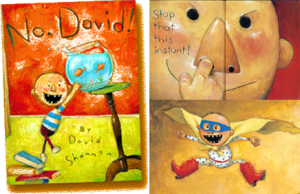 Putting a lesson together to teach the concept of “expected/ unexpected behaviors” using “No David!” would be fairly easy for most experienced clinicians. However, for me, having the resource list of children’s books that teach specific Social Thinking concepts makes Audra Jensen’s book an incredibly handy tool. An additional benefit of using children’s literature as a tool is that lessons can be planned for individual (one-on-one sessions) as well as groups.
Putting a lesson together to teach the concept of “expected/ unexpected behaviors” using “No David!” would be fairly easy for most experienced clinicians. However, for me, having the resource list of children’s books that teach specific Social Thinking concepts makes Audra Jensen’s book an incredibly handy tool. An additional benefit of using children’s literature as a tool is that lessons can be planned for individual (one-on-one sessions) as well as groups.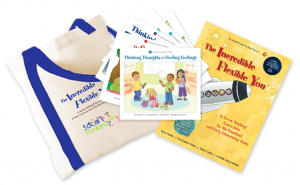 The area of language disorders that seemed to confound most therapists, including myself, for a long time was social skills or pragmatics. That was until I discovered Michelle Garcia Winner’s work. When I read her book “Thinking About YOU, Thinking About ME,” I finally felt relief. I started thinking about social skills in a completely different way that made sense. I realized that the reason my therapy tools didn’t seem powerful or effective was because I was focusing on teaching specific skills (e.g. How to start a conversation) in a specific situation (e.g. When you meet your neighbor), rather than teaching social thinking or social cognition. As a clinician, when you teach a specific skill in an artificial environment, the student may do well to learn the skill. But the questions “What happens when the situation changes? Can my student generalize this skill to another environment?” always haunted me. The knowledge that you can build a child’s perspective taking ability, or his ability to “listen with his whole body” to help him across situations and contexts, was my Eureka moment.
The area of language disorders that seemed to confound most therapists, including myself, for a long time was social skills or pragmatics. That was until I discovered Michelle Garcia Winner’s work. When I read her book “Thinking About YOU, Thinking About ME,” I finally felt relief. I started thinking about social skills in a completely different way that made sense. I realized that the reason my therapy tools didn’t seem powerful or effective was because I was focusing on teaching specific skills (e.g. How to start a conversation) in a specific situation (e.g. When you meet your neighbor), rather than teaching social thinking or social cognition. As a clinician, when you teach a specific skill in an artificial environment, the student may do well to learn the skill. But the questions “What happens when the situation changes? Can my student generalize this skill to another environment?” always haunted me. The knowledge that you can build a child’s perspective taking ability, or his ability to “listen with his whole body” to help him across situations and contexts, was my Eureka moment.